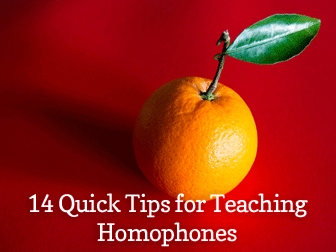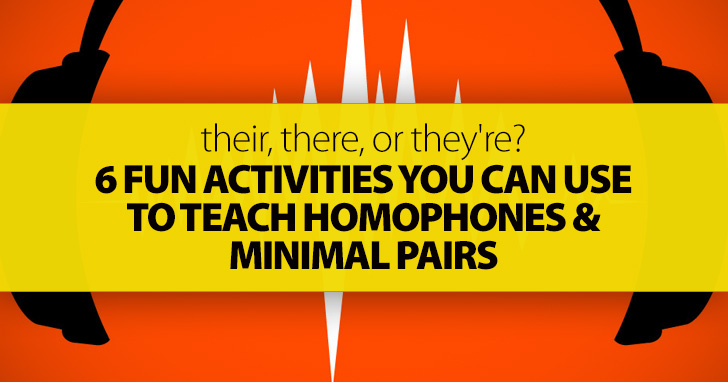14 Quick Tips for Teaching Homophones


As your students advance in their language studies, they will be challenged to use English in more and more complex ways. And with English becoming harder and requiring more care, why not take one struggle off the table by nipping simple problems in the bud – problems like homophone confusion. Homophones can be the source of silly mistakes because they are words that sound alike but are spelled differently. There, they’re, and their are one of the most common examples. The following exercises are designed to help students learn homophones and distinguish them from minimal pairs. So if you find your students getting twisted up with homophones, try these exercises to straighten them out.

Go Fish is such a versatile game with so many applications for the ELS teacher, and reviewing homophones is just one of them. Create your own set of homophone Go Fish cards with some blank index cards. Write a pair of homophones, each on their own index card, and on two additional cards glue or draw pictures which represent those words. If you like, laminate the cards, and your students are ready to play. The game plays according to traditional rules with this one exception. If a student lays down a pair that incorrectly matches the homophone to its picture, he loses his next turn. If you want to solidify the homophones in your students’ minds even more, have them create their own sets of homophone Go Fish cards and then play a round or two in groups of three or four students.
If you or your students made the cards for homophone Go Fish, use them again in this memory style homophone game. Lay all the cards out face down on a table. Students play against one other person. On their turn, they flip over two cards. If they match a homophone to its correct picture, the students keeps the cards and takes another turn. If they do not match, the student flips them back over and the other person takes a turn. Keep playing until no cards remain on the table. The person with the most pairs wins the game.
Homophones are words that sound alike but are spelled differently, such as flour and flower, which and witch. Minimal pairs, on the other hand, are two words that differ in only one sound, such as wide and wade or boy and toy. Sometimes ESL students have trouble distinguishing between the two. This class listening activity will give them a chance to test their ears and their minds as they listen to pairs of words that may or may not be homophones or minimal pairs. Start by explaining the difference between minimal pairs and homophones. Give your students some examples of each. Then give everyone two pieces of paper. On one, each person writes homophone. On the other, they write minimal pair. Students then put both signs on their desk and get ready to listen. Read students two words our loud – either a set of homophones or a set of minimal pairs. Students try to discern which you have read and then hold up the appropriate sign. Check everyone’s sign and see who got the answer right, then write the words on the board so your students can see the difference between the words they just heard. You can also review any unfamiliar words with your students. Don’t feel like you have to limit this exercise to vocabulary your students already know, either. Since it is a listening exercise, you can read words students have never heard before and get a good measure on how well they are able to listen for specific sounds in words.
This activity is similar to the previous one, but it focuses solely on minimal pairs. Have students create two signs – one that says minimal pair and the other that says same word. As in the previous exercise, say two words to your class. This time, though, they will either be two words that form a minimal pair or one word that you say twice. Students must decide if they heard the same word on time or minimal pairs and then hold up the correct sign. This exercise is particularly useful if you have students struggling with distinction between certain letters (such as l and r). If so, focus your minimal pairs on words that differ between these sounds (light and right, lice and rice, lamp and ramp).
This activity challenges ESL students to listen to a homophone and find its match from a list of words you provide. Give your students a sheet of several words (more words for more advanced listeners or if you have tried the exercise before). The list should include ONE word of several homophone pairs (i.e. leave the matching homophone off the list). For the activity, read a word that is not on the list but is a homophone to one of the words your students have in front of them. Students then race to find the homophone to the word you just read. When a student thinks she has found the match, have her come to the front board and write both of the homophones for the class to see. If you want to challenge your students even further, repeat the exercise using minimal pairs instead of homophones. Again, have students write the words on the board and then use that opportunity to teach any unfamiliar vocabulary words.
Challenge your students to listen to one another as they match words that are homophones or minimal pairs. Have your students work with a partner for this exercise. Give one person a written list of fifteen words and have them copy the words on to index cards. Ten of those words should have one word from a pair of homophones (or minimal pairs), but the matching homophones should not be on that same list. Give the other person a list of fifteen different words, ten of which are the homophones (or minimal pairs) to the first person’s words. Have that person write each word on a separate index card. For the activity, students hide their cards from their teammate. One person reads a word aloud and the second person looks through the cards in his hand to find a homophone match. If he has one, they set those cards aside. Then the other person reads a word in his hand, and his partner looks for a homophone among his cards. Students play in this manner until they have found all ten homophone pairs and each have five cards remaining in their hands. If you want to make the game even more complicated, give students a list of twenty words – ten members of a homophone pair and ten members of a minimal pair. Have them play until all twenty cards have their correct match.
English learners have enough challenges without making silly mistakes. By reviewing minimal pairs and homophones and giving them practice listening and distinguishing between the two, you will be helping them form a solid foundation for future language learning.
Share them with us in the comments below.